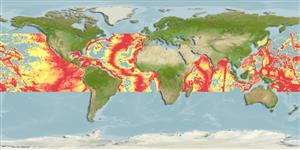Environment: milieu / climate zone / depth range / distribution range
Ecologia
marino batidemersale; distribuzione batimetrica 1550 - 4903 m (Ref. 58302), usually 2000 - ? m (Ref. 4472). Deep-water; 50°N - 20°S, 180°W - 180°E
Circumglobal between latitude 50°N-20°S except tropical eastern Pacific. Eastern Atlantic: northern Ireland; Morocco to Gabon.
Size / Peso / Age
Maturity: Lm ? range ? - ? cm
Max length : 78.0 cm SL maschio/sesso non determinato; (Ref. 4472); common length : 40.0 cm SL maschio/sesso non determinato; (Ref. 4472)
Raggi dorsali molli (totale): 16-17; Raggi anali molli: 13; Vertebre: 50 - 51. Moderately elongate and slender. Slightly depressed anteriorly and compressed posteriorly. Color generally white, with peritoneum, branchial and buccal regions dark. Small specimens have faint vertical bars (Ref. 37039).
Benthic (Ref. 58302). Found on the continental rise and the abyss, commonly below 2,000 m, in water colder than 4°C. Larvae are probably pelagic in near-surface midwaters. Solitary, lurking bottom feeder. Probably piscivore (Ref. 4964).
Life cycle and mating behavior
Maturità | Riproduzione | Deposizione | Uova | Fecundity | Larve
Contrary to Ref. 240 this species is an hermaphrodite (Ref. 7463).
Sulak, K.J., 1990. Synodontidae. p. 365-370. In J.C. Quero, J.C. Hureau, C. Karrer, A. Post and L. Saldanha (eds.) Check-list of the fishes of the eastern tropical Atlantic (CLOFETA). JNICT, Lisbon; SEI, Paris; and UNESCO, Paris. Vol. 1. (Ref. 4472)
IUCN Red List Status (Ref. 130435)
Threat to humans
Harmless
Human uses
Informazioni ulteriori
BibliografiaAcquacolturaProfilo di acquacolturaVarietàGeneticaElectrophoresesEreditarietàMalattieElaborazioneNutrientsMass conversion
CollaboratoriImmaginiStamps, Coins Misc.SuoniCiguateraVelocitàModalità di nuotoArea branchialeOtolithsCervelliVista
Strumenti
Special reports
Download XML
Fonti Internet
Estimates based on models
Preferred temperature (Ref.
123201): 1.7 - 4.1, mean 2.2 °C (based on 3164 cells).
Phylogenetic diversity index (Ref.
82804): PD
50 = 1.0000 [Uniqueness, from 0.5 = low to 2.0 = high].
Bayesian length-weight: a=0.00324 (0.00128 - 0.00816), b=3.16 (2.94 - 3.38), in cm total length, based on LWR estimates for this (Sub)family-body shape (Ref.
93245).
Trophic level (Ref.
69278): 4.5 ±0.80 se; based on food items.
Resilienza (Ref.
120179): Basso, tempo minimo di raddoppiamento della popolazione 4.5 - 14 anni (Assuming tmax>10).
Fishing Vulnerability (Ref.
59153): High vulnerability (58 of 100).
